How to grow passion fruit at home
The experience of growing exotic fruits shows that it is possible to get a fruiting plant at home. This will take a lot of work, but the result is worth it. Passion fruit is one of the most beautiful representatives of tropical cultures. The features of growing passionfruit at home will be discussed in the article.
What are these Passion Fruit plants
Passionflower edible is a representative of evergreen vines, the stems of which are rapidly gaining growth. An adult plant reaches a length of 45 meters. The original structure of openwork leaves and color of inflorescences provide high decorative properties of passion fruit. Thanks to the rapid growth of greenery and the long flowering period, the culture has gained popularity among gardeners. It is used as a decoration for gazebos, pergolas, recreation areas, garden arches and fences.
During the flowering of passionflower, leaves, buds, and inflorescences are harvested for further drying. Such blanks are used for the preparation of teas, infusions and other traditional medicine. Their composition is enriched with healing microelements that have antifungal, antispasmodic and antibacterial effect.
Passionflower is used in the manufacture of pharmacological preparations that have a sedative effect. Dry preparations are included in the composition of dietary supplements intended for the treatment of drug and alcohol addiction.
Where and how it grows in natural conditions
Passion fruit is native to tropical forests where there is a stable hot and humid climate. In South America, culture grows everywhere. Most of the varieties are concentrated in the southern regions of Brazil, Paraguay, and northern Argentina.
You can also meet the plant in some regions of Australia and Asia. More than 500 representatives of passionflower produce edible fruits. Berries have valuable nutritional properties and are positioned as a dietary product.
Reference! The calorie content of passion fruit is 68 kcal.
The aboveground part of the plant, as well as the fruits, have medicinal properties. The blanks are used in traditional and alternative medicine. Stems and leaves contain a wealth of useful chemical compounds:
- alkaloids;
- glycosides;
- carotenoids;
- flavonoids;
- quinones;
- saponins and other vitamins, minerals.
Can I grow at home
Passion fruit refers to unpretentious plants that can be grown in winter greenhouses or at home. Exotic culture will delight not only with aesthetics, but also with small fruits, the taste of which will delight gourmets. The basic requirements for caring for a representative of passionflower have something in common with the climatic features of the tropics. Heat and moisture are the main ingredients for the successful cultivation of exotic liana.
Reference! Some types of passionflower can actually be grown in the garden, provided that they are planted directly in open ground.
What conditions are required
The normal vegetation of the plant is facilitated by light. Therefore, when cultivating passion fruit indoors, you should choose a room with good lighting. Window sills located on the east or south side will do. Daylight hours should last at least 10-12 hours.
In winter, it is recommended to equip additional lighting near the tub with passionflower. The ideal option is a phytolamp.
The temperature regime in the room where the passionfruit is kept should be stable without sudden jumps. Optimal performance depending on the season:
- in the summer - from + 23 ° to + 26 °;
- in the cold season - from + 16 ° to + 18 °.
The watering regime also depends on the season. The lower the air temperature, the less moisture the plant needs. In winter, irrigation once a week is sufficient. On hot days, it is recommended to moisten the soil daily. In addition, spraying greens with a spray bottle is welcome.
The humidity in the room should not fall below 55-65%. This corresponds to the peculiarities of the tropical climate in which the vine grows well.
Where to get planting material
If a decision is made to grow passion fruit, you need to decide on the variety and planting material. It can be purchased from nurseries or obtained from cuttings. The first option is preferred. The professional approach of experienced gardeners and biologists is a guarantee of quality. Plants obtained from seeds are characterized by high resistance to common diseases and unfavorable climatic conditions.
If your friends have an adult plant, you can ask for a cutting or root cut to obtain planting material. When choosing this option, it should be borne in mind that in the process of rooting and development of a young shoot, you will have to face various problems. It will be difficult to cope without some experience.
How to choose a variety
The choice of a variety should be approached responsibly. Each type of passionflower requires special care, which makes adjustments to the agricultural technique.
Experts advise novice gardeners to consider using purple passion fruit. Its fruits taste very sweet, the plant itself tolerates a cool climate well. Yellow passionflower takes root well, but the fruit contains a lot of acid, not everyone likes it. Hybrids of these varieties are also worth considering. They are more resistant to unfavorable climatic conditions, have strong immunity.
When cultivating a plant indoors, you can opt for a winged or blue passionflower... These varieties are characterized by high decorative qualities, large leaves that are colored bright green.
Instructions for growing from seeds
A common breeding method for passionflower is seed. Its advantage lies in the fact that each phase of shoot development is controlled by the gardener. There are practically no risks. The exceptions are cases when low-quality material comes across for sowing.
Preparation
You can get seed by extracting seeds from a ripe fruit or purchasing them in a specialized store.
Reference! High germination rate for fresh seeds. When buying seed, you should pay attention to the time of harvesting and packing.
When self-extracting seeds, you need to take into account that after removing them from the fruit, thorough washing is performed. If even a small amount of pulp remains on the grains, this will prevent the sprout from sprouting. After the "bath" the material is slightly dried. The landing is planned for the spring. This is a favorable time for the development of young shoots. But experienced gardeners are engaged in germination at any time of the year.
A pot is selected with a diameter of 8-10 cm and a depth of at least 12-15 cm. A well-lit place is selected for it. Preference is given to window sills located on the south or east side.
As a filler, a ready-made soil for indoor flowers or prepared independently is used. Sod soil, humus, sand are combined in a bowl in a ratio of 2: 1: 1.
Planting instructions
The sowing process is carried out in the following sequence:
- pour a layer of expanded clay or perlite (at least 2.5 cm) on the bottom of the pot, thus arranging drainage;
- introduce the soil mixture into the pot;
- moisten the soil with a spray bottle, let it stand for about 30-50 minutes;
- loosen the soil, lay seeds (2-3 pieces in one pot), sprinkle with soil with a layer of 1.5 cm;
- moisten the landing with a spray gun;
- cover the pots with glass or transparent film;
- put crops in a bright place in the room, set the temperature regime to 20-25 degrees.
Reference! The planting is periodically ventilated and moistened. The soil should not dry out, but it is not necessary to allow moisture stagnation.
Further care
You can observe the appearance of the first shoots 20-30 days after sowing. As soon as the sprouts rise above the surface of the ground, the shelter is removed. Care mainly consists of watering and airing. After the formation of 4 true leaves on the shoots, the plant is transplanted into a container with a diameter of 40 cm. The soil mixture is suitable for the same composition as for sowing seeds.
Tables 1. Care for passion fruit.
| Care stage | Description |
| Watering | Passiflora is irrigated regularly (2-3 times a week). Despite the fact that the culture loves moisture, it is impossible to allow waterlogging of the soil. This will provoke root rot. |
| Top dressing | Vine develops intensively. Therefore, the plant requires additional nutrition. In the summertime, liquid complex compositions are introduced 1 p. in 10 days. In autumn and winter, organic feeding is used 1 p. at 1.5 months. Experienced gardeners recommend using a liquid formulation designed for tomatoes. |
| Garter | The lash develops quickly enough. For the garter, special gratings, nets, etc. are used. To maintain the interior, you should select the material from which the gratings are made. They are metal, plastic, wood. Forged construction is the ideal solution. |
Protection against diseases and pests
The main factor of protection is the timely care of the plant. Pathogenic microflora develops against the background of stagnant water in the ground. To avoid this, you need to introduce expanded clay or perlite at the bottom of the pot when planting a seedling. It is also important to add sand to the soil mixture.
An abundance of moisture, combined with low temperature indicators, leads to root rot. Before irrigation, the degree of soil moisture should be checked. If a fungal infection is detected, passion fruit should be treated with fungicides. Among the effective means:
- Fundazol;
- Bordeaux liquid;
- Trichodermin;
- Fitosporin;
- Speed
As auxiliary measures, use:
- replacement of soil;
- disinfection of the pot;
- flushing the roots and treating them with an antifungal agent;
- establishment of an irrigation regime.
Insects can also provoke a plant disease. The most common pests are: scale insects, aphids, spider mites. The infected bush is rearranged in a separate room to exclude infection of other indoor crops. With passion fruit, parasites are first mechanically removed. After the treatment is carried out using insecticides: Aktara, Fitoverm. Severe lesions should be treated with Actellik. In the fight against ticks, it is more effective to use: Neoron, Antklesch, Fufanon.
If the affected area is small, it is allowed to start treatment with folk remedies. The bush is washed with soapy water, then the greens are sprayed with garlic infusion. A decoction of tobacco leaves, a solution of succinic acid are also suitable.
Transfer
As the lash develops, it becomes necessary to transplant the plant. In the first years of life, passion fruit will have to be transplanted annually for 4 years. The flowerpot is selected according to the size of the roots. Each subsequent container should be 5 cm more spacious than the previous one (in diameter).
Reference! If the roots are cramped in the pot, the growth of the plant stops, the intensity of flowering decreases.
It is not worth using a large container for transplanting young creepers. The bush should be transferred to a new container using the transshipment method. It is not necessary to clear the soil from the root system; the processes can be damaged. The plant is transplanted into a new pot together with an old earth lump.The free space is filled with a soil mixture of a similar composition.
Reproduction
Passion fruit is propagated using cuttings and root shoots. You can also use home grown fruits. Seeds are extracted from the ripe fruit. After rinsing and drying, they are ready to plant.
Experienced gardeners believe that the easiest way to propagate is by cuttings. A shoot is cut from an adult plant, on which there are 2-3 leaves. Rooting is done in a nutrient substrate. With a regime of 21-23 degrees and regular irrigation, the stalk releases roots for 4-8 weeks. To activate the process, it is recommended to use Heteroauxin or Kornevin.
Reference! Rooted shoots are transplanted to a permanent place in a suitable pot.
How to get edible fruits at home
Most young plants throw out the original inflorescences in the first year. At the age of 1 year, passionfruit reaches a length of about 1 m.However, fruits are not always formed from the ovaries. In order for juicy fruits to form on the lash, you need to choose self-pollinating varieties for planting. The rest of the species are artificially pollinated.
Pollen is transferred from male to female inflorescences with a cotton swab. They do it very carefully. Repeat the procedure 2-3 times. If you can't grow fruit, don't despair. Passion fruit will bring a special charm to the interior, harmoniously fit into the environment, made in any design style.
In what cases it does not bear fruit and why
Experts identify the main reasons why passionflower does not bloom:
- violation of the irrigation regime;
- cramped pot;
- low or too high temperatures;
- lack of pollination;
- deficiency of nutrients in the soil;
- pathological processes.
Features of growing from a bone
This method will have to tinker with, so experimenters should be patient. The cultivation process includes the extraction of seeds from the fruit. They are thoroughly cleaned of pulp, and then dried in natural conditions.
The pot must be taken with a diameter of 10 cm. Drainage is made in the bottom part. A lightweight nutritious soil mixture is poured on top. The seed is planted in the soil, deepening by 2 cm. After moistening, the container is placed in a warm place. The room maintains humidity at 65-70%, temperature - from 20 to 23 degrees. After 4-6 weeks, a sprout will appear above the surface of the soil. It is transplanted into another pot after 3-4 true leaves are formed on the shoot.
Tips on the topic
To avoid mistakes when growing passionflower, it is recommended to heed the advice of experts.
- The plant bears fruit very quickly. The life cycle is 6 years. The most productive is considered to be 2-3 years. In the 4th year, the number of fruits decreases sharply. Intensive vegetation requires regular feeding.
- To get a good harvest every year, you need to plant new plants every year.
- The rapid growth of the bush requires an obligatory garter. To make the passion fruit look aesthetically pleasing in the room, a suspension system should be developed. A mesh construction is ideal.
- Sowing material is considered to be of higher quality, which is extracted from overripe fruits with wrinkled skin. It is recommended to plant them immediately. Gatherings appear after 2-2.5 weeks.
- Passionflower species respond well to organic fertilizers.
To facilitate the care of passionfruit, experts advise using a special calendar, which contains all the rules of agricultural technology with the set schedules of events.
Related videos:




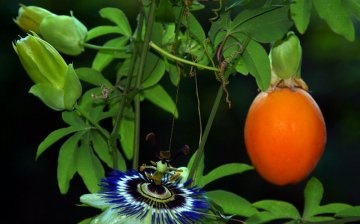
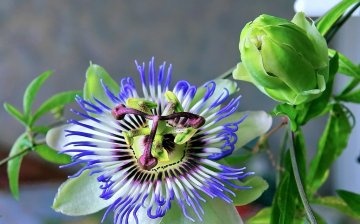



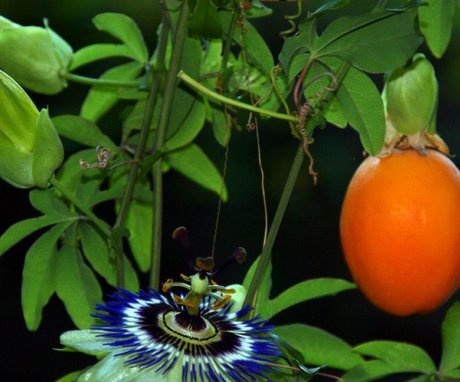
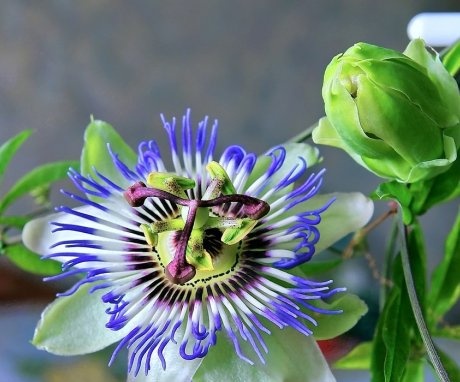
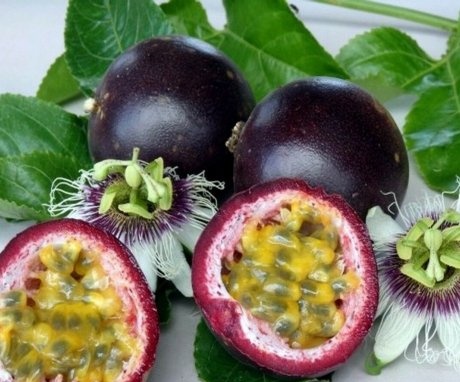
According to the description, passion fruit is easier to grow from seeds. In an apartment, the plant may well develop, of course, if the soil in the pot has drainage, and the liana itself is regularly irrigated with water. It is better to buy self-pollinated passion fruit seeds, then there will be no problems with the formation of fruits.
We grew pineapple in a similar way. True, it "took root" not from the bone, but from the freshly cut upper part of the fruit.
But soil preparation, care = watering, transplanting, everything is exactly the same.
Apparently, by their "nature" the fruits from the tropics are not very different ...
Most of my attempts to grow exotic plants at home have consistently failed. In this case, the size of an adult plant is immediately stopped, it fits under an indoor heated winter garden, I do not have such an opportunity yet.